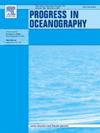温带大陆架系统中个体发生迁移过程中日本凤尾鱼的营养生态位变化
IF 3.6
3区 地球科学
Q1 OCEANOGRAPHY
引用次数: 0
摘要
了解驱动鱼类个体发生生态位变化的机制主要集中在大型掠食性洄游动物的饮食变化上。本研究调查了一种小型远洋洄游鱼类,日本凤尾鱼(Engraulis japonicus)的营养生态位动态。通过绘制朝鲜水域温带大陆架不同海洋区域的迁徙路径,我们使用δ13C和δ15N值量化了不同个体发育阶段(幼鱼、亚成鱼和成鱼)的营养生态位变化。我们假设与鱼类个体发育和迁徙相关的生物和生态过程引起了营养生态位的变化。结果表明,幼年凤尾鱼的营养生态位狭窄,随着它们的成熟而扩大,这表明它们的摄食习惯从专门性向通用性转变,这与许多大型掠食性鱼类不同。不同生命阶段的同位素生态位重叠有限,表明各阶段共存的近岸生境中存在生态位划分。与生活史相关的形态和行为特征可能驱动了这些摄食模式和猎物利用的变化。同位素剖面随迁徙路线的变化而变化,反映了浮游动物同位素基线的空间变化。成虫δ13C在南部近海(长江稀释水域)高于近海(韩国沿海水域),δ15N在东部近海(对马暖流地区)低于近海(韩国沿海水域),形成了不同的同位素生态位。这种同位素变化可能是由于不同的低营养层过程和浮游动物组合,正如我们的饮食混合模型所支持的那样。我们的研究结果强调,摄食习惯的个体发生变化和对猎物可获得性的适应性反应促进了日本凤尾鱼营养生态位的变化。本文章由计算机程序翻译,如有差异,请以英文原文为准。
Trophic niche shifts in Japanese anchovy, Engraulis japonica, during ontogenetic migration in a temperate continental shelf system
Understanding the mechanisms driving ontogenetic niche shifts in fishes has predominantly focused on dietary changes in large predatory migrants. This study investigates trophic niche dynamics in a small, pelagic migratory fish, the Japanese anchovy (Engraulis japonicus). By mapping migratory paths across varied oceanographic regions on a temperate continental shelf of Korean waters, we quantified changes in the trophic niche using δ13C and δ15N values across different ontogenetic stages (juvenile, subadult, and adult). We hypothesized that biological and ecological processes associated with fish ontogeny and migration cause trophic niche shifts. Results showed that juvenile anchovies had a narrow trophic niche, which expanded as they matured, indicating a shift from specialist to generalist feeding habits, unlike many large predatory fishes. Limited isotopic niche overlap among life stages suggested niche partitioning within inshore habitats where all stages coexist. Morphological and behavioral traits related to life history likely drive these feeding modes and prey use changes. Isotopic profiles varied with migratory routes, reflecting spatial variations in zooplankton isotope baselines. Adults showed higher δ13C in the southern offshore (Yangtze River Diluted Water area) and lower δ15N in the eastern offshore (Tsushima Warm Current area) compared with inshore (South Korea Coastal Water area), resulting in distinct isotopic niches. This isotopic variation is likely due to differing lower trophic-level processes and zooplankton assemblages, as supported by our dietary mixing model. Our findings highlight that ontogenetic changes in feeding habits and adaptive responses to prey availability along their migratory paths facilitate trophic niche shifts in Japanese anchovy.
求助全文
通过发布文献求助,成功后即可免费获取论文全文。
去求助
来源期刊

Progress in Oceanography
地学-海洋学
CiteScore
7.20
自引率
4.90%
发文量
138
审稿时长
3 months
期刊介绍:
Progress in Oceanography publishes the longer, more comprehensive papers that most oceanographers feel are necessary, on occasion, to do justice to their work. Contributions are generally either a review of an aspect of oceanography or a treatise on an expanding oceanographic subject. The articles cover the entire spectrum of disciplines within the science of oceanography. Occasionally volumes are devoted to collections of papers and conference proceedings of exceptional interest. Essential reading for all oceanographers.
 求助内容:
求助内容: 应助结果提醒方式:
应助结果提醒方式:


